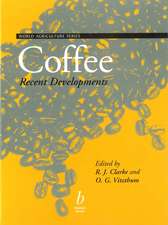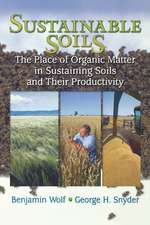Precision in Crop Farming: Site Specific Concepts and Sensing Methods: Applications and Results
Editat de Hermann J. Heegeen Limba Engleză Hardback – 15 iul 2013
| Toate formatele și edițiile | Preț | Express |
|---|---|---|
| Paperback (1) | 1547.00 lei 6-8 săpt. | |
| SPRINGER NETHERLANDS – 7 aug 2015 | 1547.00 lei 6-8 săpt. | |
| Hardback (1) | 1551.90 lei 6-8 săpt. | |
| SPRINGER NETHERLANDS – 15 iul 2013 | 1551.90 lei 6-8 săpt. |
Preț: 1551.90 lei
Preț vechi: 1892.56 lei
-18% Nou
Puncte Express: 2328
Preț estimativ în valută:
297.05€ • 322.77$ • 249.68£
297.05€ • 322.77$ • 249.68£
Carte tipărită la comandă
Livrare economică 21 aprilie-05 mai
Preluare comenzi: 021 569.72.76
Specificații
ISBN-13: 9789400767591
ISBN-10: 9400767595
Pagini: 300
Ilustrații: XI, 356 p.
Dimensiuni: 155 x 235 x 22 mm
Greutate: 0.66 kg
Ediția:2013
Editura: SPRINGER NETHERLANDS
Colecția Springer
Locul publicării:Dordrecht, Netherlands
ISBN-10: 9400767595
Pagini: 300
Ilustrații: XI, 356 p.
Dimensiuni: 155 x 235 x 22 mm
Greutate: 0.66 kg
Ediția:2013
Editura: SPRINGER NETHERLANDS
Colecția Springer
Locul publicării:Dordrecht, Netherlands
Public țintă
Upper undergraduateCuprins
1 Introduction.- 2 Heterogeneity in Fields: Basics of Analyses.- 3 Sensing by Electromagnetic Radiation.- 4 Precision in Guidance of Farm Machinery.- 5 Sensing of Natural Soil Properties.- 6 Sensing of Crop Properties.- 7 Site-Specific Soil Cultivation.- 8 Site-Specific Sowing.- 9 Site-Specific Fertilizing.- 10 Site-Specific Weed Control.- 11 Site-Specific Sensing for Fungicide Spraying.- 12 Site-Specific Recording of Yields.- 13 Fusions, Overlays and Management Zones.- 14 Summary and Perspectives.- Index.
Recenzii
From the reviews:
“This well-designed, well-written book covers appropriate topics related to production crop farming anywhere in the world. … This book can be used in a beginning and/or intermediate precision farming course. It can also serve as a reference in a more comprehensive course or series of courses on precision crop farming. The material presented will enhance students’ knowledge of specific production practices. Summing Up: Highly recommended. Upper-division undergraduates, graduate students, researchers/faculty, and professionals/practitioners.” (M. K. Swan, Choice, Vol. 51 (8), April, 2014)
“This well-designed, well-written book covers appropriate topics related to production crop farming anywhere in the world. … This book can be used in a beginning and/or intermediate precision farming course. It can also serve as a reference in a more comprehensive course or series of courses on precision crop farming. The material presented will enhance students’ knowledge of specific production practices. Summing Up: Highly recommended. Upper-division undergraduates, graduate students, researchers/faculty, and professionals/practitioners.” (M. K. Swan, Choice, Vol. 51 (8), April, 2014)
Notă biografică
The editor and main author – Hermann J. Heege – is Professor Emeritus of the University of Kiel and was formerly head of its Department of Agricultural Systems Engineering. He conceived and initiated the worldwide known concept of the “N Sensor”.
The chapter about weed control is from Roland Gerhards, Professor of the University of Stuttgart-Hohenheim.
Contributions about the use of plant-fluorescence are from Eiko Thiessen, Postdoctoral Research Associate in the Department of Agricultural Systems Engineering of the University of Kiel.
Markus Demmel from the Bavarian State Research Center for Agriculture in Freising-Weihenstephan and its section head for System Engineering in Crop Farming is author of the chapter about yield sensing.
The chapter about weed control is from Roland Gerhards, Professor of the University of Stuttgart-Hohenheim.
Contributions about the use of plant-fluorescence are from Eiko Thiessen, Postdoctoral Research Associate in the Department of Agricultural Systems Engineering of the University of Kiel.
Markus Demmel from the Bavarian State Research Center for Agriculture in Freising-Weihenstephan and its section head for System Engineering in Crop Farming is author of the chapter about yield sensing.
Textul de pe ultima copertă
High yields and environmental control in crop farming call for precise adaptations to local growing conditions. Treating large fields in a uniform way by high capacity machinery cannot be regarded as a sustainable method for many situations. Because differences existing within single fields must be considered. The transition from former field work carried out manually or by small implements to present day high capacity machinery caused that the farmers lost the immediate and close contact with soils and crops.
However, modern sensing and controlling technology can make up for this deficit. High tech methods that include proximal sensing and signals from satellites can provide for controls that allow adjusting farming operations to small fractions of one ha and sometimes even down to some m2, hence in a site-specific mode. This applies to operations for soil cultivation, sowing, fertilizing and plant protection.
This book deals with concepts, applications and results, and has an interdisciplinary approach that pervades all chapters.
However, modern sensing and controlling technology can make up for this deficit. High tech methods that include proximal sensing and signals from satellites can provide for controls that allow adjusting farming operations to small fractions of one ha and sometimes even down to some m2, hence in a site-specific mode. This applies to operations for soil cultivation, sowing, fertilizing and plant protection.
This book deals with concepts, applications and results, and has an interdisciplinary approach that pervades all chapters.
Caracteristici
Interdisciplinary approach that pervades all chapters The concept to deal with complicated topics simply 178 illustrations, half in colour









